Education in Pittville
Introduction
 “Salubritas et eruditio”: Cheltenham’s motto and coat of arms make reference to learning, an important factor in the growth of the town. Cheltenham College, the Ladies’ College and Dean Close School are amongst the town’s best-known institutions. But what contribution did Pittville make to the educational life of Cheltenham in the 19th and early 20th century?
“Salubritas et eruditio”: Cheltenham’s motto and coat of arms make reference to learning, an important factor in the growth of the town. Cheltenham College, the Ladies’ College and Dean Close School are amongst the town’s best-known institutions. But what contribution did Pittville make to the educational life of Cheltenham in the 19th and early 20th century?This article is divided into two sections: the first, by Mark Penfold, looks at the cluster of schools that sprang up in Pittville Circus Road; the second, by Sandy Marshall, looks at the range of schools that emerged in the rest of Pittville.
This article consists of two sections: firstly, Preparatory Schools in Pittville Circus Road, 1860 – 1945 by Mark Penfold, and secondly, Other educational establishments in Pittville, 1870-1950 by Sandy Marshall
This article consists of two sections: firstly, Preparatory Schools in Pittville Circus Road, 1860 – 1945 by Mark Penfold, and secondly, Other educational establishments in Pittville, 1870-1950 by Sandy Marshall
1) Preparatory Schools in Pittville Circus Road, 1860 – 1945
by Mark Penfold
Introduction Berkhampstead School, founded in 1945, has been providing education locally for over seventy years – but was not the first school in the area to do so. This section provides a brief overview of the preparatory schools that were established in Pittville Circus Road in the second half of the 19th and early 20th centuries.
Pittville Circus Road Boarding Schools
Pittville Circus lies on the eastern boundary of the Pittville Estate and was laid out in 1839-40 by Edward Cope, a local builder, on land acquired from Joseph Pitt. Subsequently, Pittville Circus Road was constructed, linking the Circus to All Saints Road and to the Hewletts. A number of large Victorian mansions with extensive grounds were built along Pittville Circus Road from the 1840s onwards, many of them originally as private residences, but they were later to prove suitable premises for the establishment of private boarding schools, starting in the early 1860s, including:
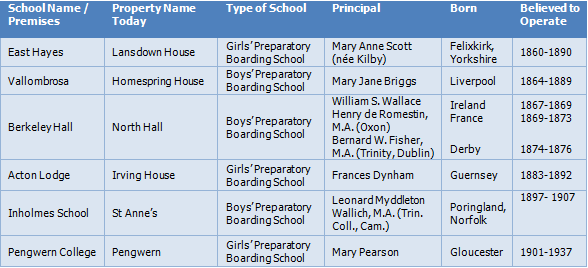
Private Schools in Context
In the 19th century, there were a large number of small private schools in Cheltenham. There was no effective regulation of schools and there were no legal requirements in respect of teacher training and qualifications. Educational standards varied considerably, and some schools closed after a few years of operation.
The number of small private schools would begin to reduce following the passing of the Elementary Education Acts from 1870. A national system of state education would introduce compulsory attendance for children up to ten years of age in England and Wales (1880), free elementary schooling in board and voluntary schools (1891) and would gradually lead to larger and better-equipped schools.
In Pittville, however, some small private schools operated quite successfully for many years, establishing themselves in Pittville Circus Road, attracted by the ample accommodation and spacious grounds offered by the properties there. Many of these schools were existing schools that moved to Pittville Circus Road from elsewhere in Cheltenham or from outside the town, although some new schools were also opened there. All of them were boarding schools but some advertised for day pupils as well. They had very broad catchment areas drawing pupils from across the country and overseas. Class sizes were small by today’s standards.
The boys’ preparatory schools were geared to preparing students for admission to English public schools, particularly Cheltenham College, and from there to university, as well as for admission to military academies such as Sandhurst and Woolwich. Some students went on to careers in the British establishment, in the civil and military, notably in the Indian subcontinent, and in commerce.
The girls’ preparatory schools were geared to providing an education for later life in the Victorian era. University education for women, on an equal basis as for men, was at that time unattainable. Oxford and Cambridge Universities required applicants to be male, single and members of the Church of England, in order to admit them.

Note: Number of pupils excludes relatives of school principal and any day students;
number of teaching staff and number domestic staff will exclude any people who did not live at the premises
The schools in Pittville Circus Road acquired a good reputation, providing an education to the sons and daughters of wealthy gentleman, many with Indian connections, who could afford the fees.


number of teaching staff and number domestic staff will exclude any people who did not live at the premises
East Hayes
Type of school: Girls’ Preparatory Boarding School Principal: Mary Anne Scott, née Kilby (born Felixkirk, Yorkshire) Period of operation: 1860 – 90 (approx.) Current property name: Lansdown House Link to large-scale OS map (1884): East Hayes (north side of Circus Road, towards eastern end)

The first school to be established in Pittville Circus Road was at East Hayes, where Mary Anne Scott opened a preparatory boarding school for girls around 1860. East Hayes, a fine mansion towards the eastern end of Pittville Circus Road, had been built by Edward Cope during the 1840s for Reverend John Browne, LLB, the curate of Trinity Church and Vice President of Cheltenham College, following a public subscription. It had been the first house to be completed along the road.
George Rowe, in his Illustrated Cheltenham Guide of 1845, sketched East Hayes, writing:
“The house is a plain but handsome erection, and when the plantations around it are advanced to maturity, and similar mansions erected on the adjacent plots of building ground, this, as an extension of Pittville to the eastward, will become a most desirable site for genteel residences.”
The property appears to be fundamentally unchanged today, nearly 175 years later.

 Left:
Left: (left) East Hayes, 1845 (George Rowe); (right) Lansdown House, 2018
While a boarding school, East Hayes was the birth place in 1885 of a notable grandson of Mrs Scott, Captain Arthur Kilby. During the First World War, Captain Kilby was awarded the Military Cross for his actions at Ypres in 1914 and the Victoria Cross for bravery in action on the first day of the Battle of Loos in 1915.
After the school closed, Mrs Scott continued to live at East Hayes for part of the 1890s until her death in 1897. Her son, Laurence Scott, an artist who exhibited on a number of occasions at the Royal Academy and the Royal Institution, lived with her. He gave painting and drawing classes at East Hayes and also exhibited there.
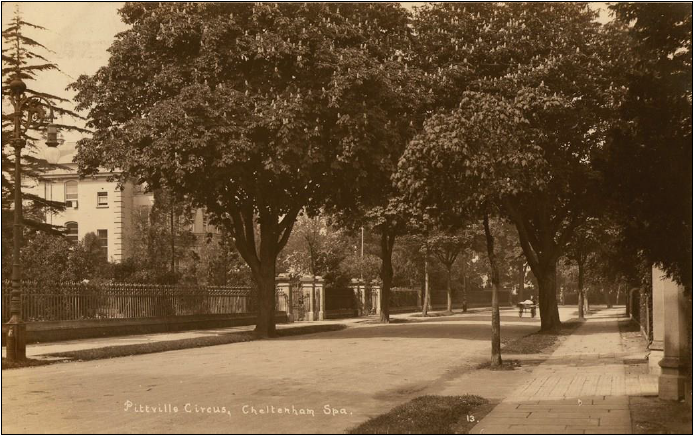
Pittville Circus Road, c1923, looking east towards East Hayes and Vallombrosa (Pittville History Works)
| Type of school: | Girls’ Preparatory Boarding School |
| Principal: | Mary Anne Scott, née Kilby (born Felixkirk, Yorkshire) |
| Period of operation: | 1860 – 90 (approx.) |
| Current property name: | Lansdown House |
| Link to large-scale OS map (1884): | East Hayes (north side of Circus Road, towards eastern end) |


 Left:
Left: 
Vallombrosa
Type of school: Boys’ Preparatory Boarding School Principal: Mary Jane Briggs (born Liverpool) Period of operation: 1864 – 89 Current property name: Homespring House Link to large-scale OS map (1884): Vallombrosa (north side of Circus Road, towards eastern end)

Like East Hayes, the neighbouring Vallombrosa was a fine, large mansion with extensive grounds built during the 1840s. From 1854-58 it was the residence of General Sir James Archibald Hope, GCB, a decorated army officer who had been with Wellington in Spain during the Peninsular War. Around 1858, he moved to the newly built Balgowan House nearby on Pittville Circus Road (now demolished and replaced with the block of flats that is Fairhavens Court), where he died in 1871.
In 1864, Mary Jane Briggs opened her preparatory boarding school for boys at Vallombrosa, although she had actually founded the school some fifteen years earlier in the Lansdown area of Cheltenham. She ran the school in Pittville Circus Road for twenty-five years, acquiring a very good reputation, particularly at Cheltenham College. A number of her pupils were awarded scholarships to English public schools, military academies and universities.
You can read more about Mary Jane Briggs in the accompanying article on the Pittville History Works website.
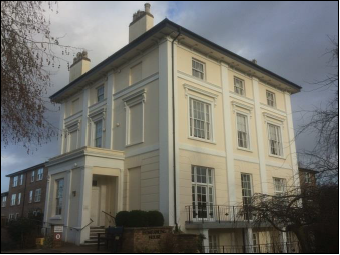
Vallombrosa (now Homespring House), 2018
| Type of school: | Boys’ Preparatory Boarding School |
| Principal: | Mary Jane Briggs (born Liverpool) |
| Period of operation: | 1864 – 89 |
| Current property name: | Homespring House |
| Link to large-scale OS map (1884): | Vallombrosa (north side of Circus Road, towards eastern end) |


Berkeley Hall
Type of school: Boys’ Preparatory Boarding School Principals: William S. Wallace (1867-69) b. Ireland; Rev. Henry de Romestin, M.A. (Oxon) (1869-73) b. France; Bernard W. Fisher, M.A. (Trinity, Dublin) (1874-76) b. Derby Period of operation: 1867 – 76 Current property name: North Hall Link to large-scale OS map (1884): Berkeley Hall (south side of Circus Road, at its western end)

East Hayes and Vallombrosa were situated on the north side of Pittville Circus Road. In fact, until the 1860s, all development had been to the north of the road. By the mid-1860s, residential development had commenced on the south side at its western end close to the site of All Saints Church. Berkeley Hall, known as North Hall today, was one of the first completed properties to be occupied.

Berkeley Hall (now North Hall), 2018

William Wallace’s earlier school at Berkeley Villa, Berkeley Street, Cheltenham
From: Berkeley Villa Scholar’s Manual (Cheltenham, 1848), frontispiece and foll. p. 128.
The book includes a listing of the contents of the school library
Courtesy of Cheltenham Local & Family History Library
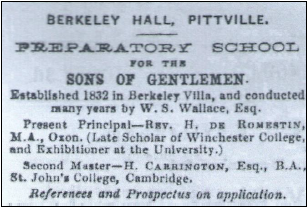
Cheltenham Looker-On, 30 October 1869

Cheltenham Looker-On, 10 January 1874
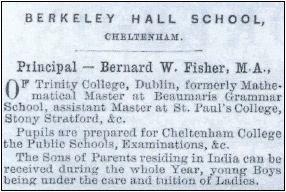
However, this did not appear to meet with success and in 1876 Bernard Fisher left Pittville Circus Road.
Berkeley Hall became the residence of the splendidly named Newman Burfoot Thoyts, a retired Indian Army Colonel, Alderman and Mayor of Cheltenham from 1888 to 1891.
| Type of school: | Boys’ Preparatory Boarding School |
| Principals: | William S. Wallace (1867-69) b. Ireland; Rev. Henry de Romestin, M.A. (Oxon) (1869-73) b. France; Bernard W. Fisher, M.A. (Trinity, Dublin) (1874-76) b. Derby |
| Period of operation: | 1867 – 76 |
| Current property name: | North Hall |
| Link to large-scale OS map (1884): | Berkeley Hall (south side of Circus Road, at its western end) |



From: Berkeley Villa Scholar’s Manual (Cheltenham, 1848), frontispiece and foll. p. 128.
The book includes a listing of the contents of the school library
Courtesy of Cheltenham Local & Family History Library



Acton Lodge
Type of school: Girls’ Preparatory Boarding School Principal: Frances Dynham (born Guernsey) Period of operation: 1883 – 92 (approx.) Current property name: Irving House Link to large-scale OS map (1884): Acton Lodge (south side of Circus Road, towards western end)

The Misses Dynham (two sisters, Frances and Alice) opened their boarding school at Acton Lodge around 1883, with Frances Dynham as principal, and for ten years educated the daughters of gentlemen, with an emphasis on foreign-language teaching.

Cheltenham Looker-On, 15 September 1888
In the summer of 1892, the Misses Dynham moved to 2, Fauconberg Terrace in Cheltenham and Acton Lodge (now part of Irving House) reverted to a private residence.

Acton Lodge (now part of Irving House), 2018
| Type of school: | Girls’ Preparatory Boarding School |
| Principal: | Frances Dynham (born Guernsey) |
| Period of operation: | 1883 – 92 (approx.) |
| Current property name: | Irving House |
| Link to large-scale OS map (1884): | Acton Lodge (south side of Circus Road, towards western end) |



Inholmes School
Type of school: Boys’ Preparatory Boarding School Principal: Leonard M. Wallich, M.A. (Trin. Coll., Cam.) (b. Poringland, Norf.) Period of operation: 1897 – 1907 Current property name: St Anne’s Link to large-scale OS map (1884): Donore (south side of Pittville Circus Road, at its western end)

In 1897, Leonard M. Wallich, M.A., the son of a vicar from Great Poringland, Norfolk, and a teacher with around twenty years’ experience, decided to relocate his school, Inholmes School, to Pittville from Burgess Hill, Sussex, owing to “insufficient accommodation”.
There was certainly sufficient accommodation at the premises he moved to, namely twenty-two rooms together with a large field of some six acres for games. He chose a property next to Berkeley Hall that had changed name several times, given its reputation, and may well have obtained favourable terms on the lease. Garden Reach had been the unhappy home of Henry Swinhoe and was reputed to be haunted. The name of the property was changed by each subsequent owner, first to Pittville Hall by Mr & Mrs Littlewood, then to Donore by Captain Despard, then again to Inholmes by Leonard Wallich.

Former premises of Inholmes School, today St Anne’s, Pittville Circus Road, c1920s (Pittville History Works) and 2018
Advertised academic successes included three pupils passing the Cambridge University local examinations (junior), one with honours and one with distinction (December 1897), and another being awarded a scholarship to Lancing College (July 1898), although these probably related to his Sussex-based pupils.
The school in Pittville Circus Road closed after ten years in 1907, and the premises became an Ursuline Convent, retaining the name of Inholmes. Leonard Wallich moved to Watford with his family, becoming headmaster at Gisburne House School, but subsequently emigrated to Winnipeg, Canada, where he set up another preparatory school. He died in Canada in 1918.
| Type of school: | Boys’ Preparatory Boarding School |
| Principal: | Leonard M. Wallich, M.A. (Trin. Coll., Cam.) (b. Poringland, Norf.) |
| Period of operation: | 1897 – 1907 |
| Current property name: | St Anne’s |
| Link to large-scale OS map (1884): | Donore (south side of Pittville Circus Road, at its western end) |


Pengwern College
Type of school: Girls’ Preparatory Boarding School Principal: Mary Pearson (born Gloucester) Period of operation: 1901 – 37 Current property name: Pengwern Link to large-scale OS map (1884): Pengwern (next to Sunnyside, diagonally opposite Vallombrosa)

Pengwern School was founded by Mary Pearson on the site of St Anne’s Promenade in Albion Street but moved to large, newly built premises (twenty-eight rooms) in Pittville Circus Road in 1901. The name change to Pengwern College appears to date from the time of the move to the new site. It is situated towards the eastern end of the road, on the south side. Its principal was Gloucester-born Mary Pearson and under her direction it became a relatively large school, with sixty-five girls boarding there by 1911.

Pengwern College, past and present (1901 and 2018)
The Gloucestershire Echo described the displays thus:
”They were remarkable for their complexity, many of the exercises being nothing short of mass juggling feats in which skipping-ropes, ranges, balls, hoops and plates were used to demonstrate co-ordination of mind and body. Many of the exercises took place to the music of well-known military bands.” (16 February 1937)
The much-decorated Major-General Sir John Duncan, K.C.B., C.M.G., D.S.O., after seeing the 1929 display, enthused:
”I have seen military displays at Olympia and at many military tattoos and tournaments, but I have never seen one to surpass this in skill, precision and rhythm.” (16 February 1937)
Photographs of the displays were published nationally and internationally, leading to girls from as far afield as Russia, the United States, South America and Africa attending Pengwern. The displays also raised money for local charities and institutions, reportedly amounting to some £1,500 in total.
You can view a Pengwern College display from 1930 entitled “Slick Drill” in this Pathé Newsreel clip.
Pengwern was a long-standing school, operating for over thirty-five years in Pittville Circus Road by the time it closed in 1937. The Pearsons decided to retire to Ilfracombe, the pupils were transferred to other schools and the premises were sold by auction.
During the Second World War, Pengwern was a maternity hospital, and the actor Martin Jarvis was born there in 1941.
| Type of school: | Girls’ Preparatory Boarding School |
| Principal: | Mary Pearson (born Gloucester) |
| Period of operation: | 1901 – 37 |
| Current property name: | Pengwern |
| Link to large-scale OS map (1884): | Pengwern (next to Sunnyside, diagonally opposite Vallombrosa) |


Berkhampstead School
In 1945, at the end of the war, Berkhampstead School was established by Edna Andrews in her home (‘Berkhampstead’), continuing the provision of education locally. The school subsequently expanded into Fernbank, a Grade-2 listed building on the south side of Pittville Circus Road. It opened with twenty-two pupils, with boys aged from three to eleven and girls aged from three to eighteen. Fees were £5 per term.
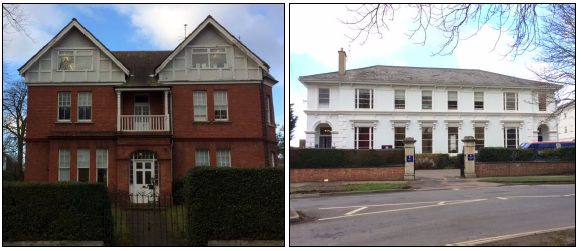
Berkhampstead and Fernbank, 2018
In conclusion, the education system has clearly changed enormously since the Victorian era. The single-sex boarding schools along Pittville Circus Road have long since disappeared and, with them, the Victorian educational ethos. Today, an independent, co-educational school educates day pupils based on a different, modern ethos. Nevertheless, there has been an almost unbroken run of private schools offering preparatory education in Pittville Circus Road from the 1860s, and that tradition remains alive today.
Mark Penfold
February 2018

Sources: Ancestry; Cheltenham Annuaires & Directories; Cheltenham College; British Newspaper Archive; Berkhampstead School website; BBC Gloucestershire; Wikipedia; other information in the public domain available through the World Wide Web. The assistance of Cheltenham Library with this article is gratefully acknowledged.)
2) Other educational establishments in Pittville, 1870-1950
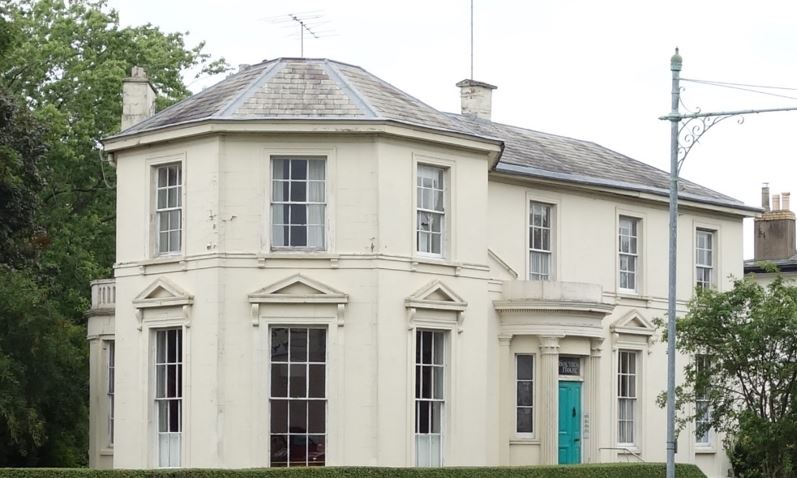
Southend House, Prestbury Road, the site of one of the establishments called
The Pittville Preparatory School
Many of the large buildings on the Pittville estate had originally housed single well-to-do families, but changes to society from the late nineteenth century brought a broader range of residents to Pittville. Household sizes became smaller and some of the larger houses were given over to multiple occupation, and still others found new uses as schools. Some of these educational establishments catered for just a few pupils, in what was in effect a private house, two different establishments had the same name, and one became the girls’ grammar school for the town. Although the 1870 Education Act enabled elementary education for all children – rich or poor, boy or girl – the schools that emerged in Pittville around that time were private, fee-paying establishments.
The history of these schools is discussed in more detail below.

The Pittville Preparatory School
Pittville Preparatory School, Wellington Square (1854-8)
The earlier of the two schools which shared the same name Pittville Preparatory School was sited in Wellington Square, in the house then known as The Aviary (now the site of Cranley Lodge). In January 1854 Miss E. Hadley (‘from Derby’) advertised the opening of her new school for boys (sons of ‘Gentlemen and Professional Men’) up to the age of eight; the school was run under the direction of the Headmaster of the Grammar School. Latin and Arithmetic were to be taught, along with French, Drawing, and Vocal Music, though the teacher for Calisthenics (a form of strength training) had yet to be appointed. The school opened on 1 February 1854, and younger pupils were to be taught on the Scotch ‘Gallery’ system. Boarders were charged 35 guineas a year (with an extra two guineas added for ‘Washing’), whereas day boarders were charged £20 a year; day pupils under the age of six paid six guineas, and those above the age of six paid eight guineas. In general, Miss Hadley offered dancing and French each at an extra two guineas a year. Perhaps presciently, given the later appearnce of the school bus, ‘an omnibus has been engaged to convey all the younger Children to and from School, without extra charge’ (Cheltenham Chronicle, 12 January).
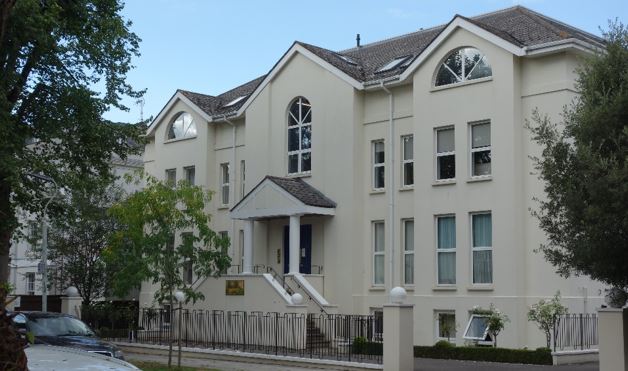
Cranley Lodge, on the site of the short-lived Pittville Preparatory School
in Wellington Square, in the house known as The Aviary.
Samuel Sharpe claimed in his advertisement to have ‘thirteen years’ experience in Private Tuition’, and it seemed as if the school, with its support from the long-established Grammar School nearby in the High Street, was expanding. But it turned out that Sharpe was involved in a long series of frauds, both in Britain and abroad. He remained at the school until 1858 but in 1866 his past finally caught up with him, and he was declared bankrupt. He soon left the country for France and then Ireland to avoid the attentions of the English police and died at Carnoustie, Angus in 1868. While the Grammar School has continued to this day, this Pittville Preparatory School was short-lived, and was no longer running in 1859.

in Wellington Square, in the house known as The Aviary.
Laurel Lodge School (1835-6)
Next to The Aviary in Wellington Square stands Laurel Lodge, which was the site of a school established by Mrs Mary Mechelen in 1835, and intended as a boarding school for twelve girls. Mrs Mechelen had previously run similar establishments in Bath and then Bristol, but her husband Joseph (also Josiah) was being sued for bankruptcy in 1835, and the finances of the school were unstable. Gloucestershire Archives holds a document relating to an action for trespass brought by Joseph in 1835 against an Elizabeth Wallace; apparently she thought the rent was overdue and forced entry and removed goods! In any event, Mrs Mechelen could not meet her rent of £170 per annum and the school moved in the following year to Sussex House, Winchcombe Street, before the unfortunate Mechelens left Cheltenham in the late 1830s.
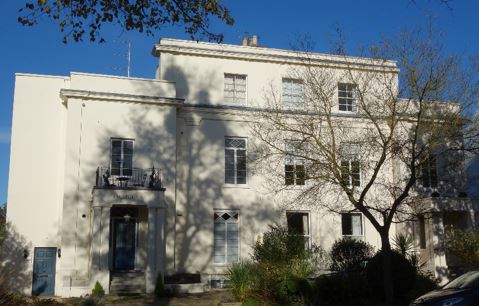 lL
lLLaurel Lodge, on the left, where the Mechelens planned
a boarding school for girls.To the right is Percy House,
the site of another short-lived school.
 lL
lLa boarding school for girls.To the right is Percy House,
the site of another short-lived school.
Percy House (1845-52)
The other half of the building that houses Laurel Lodge is Percy House, where a short-lived school was established in 1845 by the Revd. William Gilbard. The school claimed to offer its pupils a combination of ‘the comforts of home…with the advantages of a Public School.’ In October 1847, however, the Revd. Gilbard moved the school and its pupils out of Cheltenham to Woodchester Lawn, near Stroud. Woodchester was his wife’s village: Gilbard’s father-in-law had lived in Pittville from 1841 (his brother-in-law was also a Pittville clergyman). In 1851 eight boarding pupils were living in his house – the school lasted a little longer in Woodchester than it had in Pittville. The following year, however, the Rev Gilbard returned to clerical duties.
A notice by John Barnett of Percy House advertises his services as a singing teacher; in March 1884 the Cheltenham Examiner lists a “J Latham” at Percy House as one of the candidates who ‘satisfied the examiners’ at Cambridge Local Examinations, Junior Division, but to date no evidence has been found that the building was used as a school after the departure of the Gilbards. By 1902 the house was to let and seems subsequently to have been a private residence.
Miss Calderwood’s school at 17 Pittville Villas (1889-90)
Another short-lived school was established at 17 Pittville Villas (now 34 Prestbury Road). It was set up by Marion Calderwood, who is recorded in 1871 and 1881 as a teacher at Vallombrosa, in Pittville Circus Road (see Mark Penfold’s article at Education in Pittville). Marion’s own school in Pittville Villas, another preparatory school for boys, was up and running by May 1889, and advertised the new term a year later in 1890, but in 1891 the house was uninhabited.

Cheltenham Looker-On 27 April 1889

Pittville Preparatory School, Southend House, Prestbury Road (1890-1921)
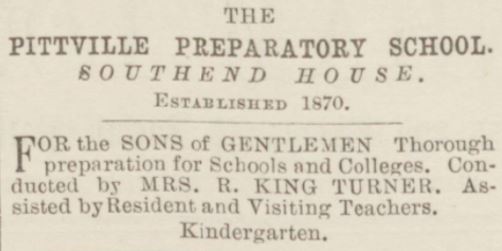
The Cheltenham Looker-On, 11 March 1899
From time to time the local papers noted examination successes by Mrs King-Turner’s pupils, at first in the College of Preceptors’ exams: in 1896 Mrs King-Turner’s son Harry, a pupil of the Pittville Preparatory School, passed his exams in the 1st Division for his year (the Third Class, or year group), and in the following year, he remained in the 1st Division when he took his exams in the Second Class (it was noted that his marks entitled him to register as a medical student, should he want to). In 1892 Arthur Rae, who lived at Berkeley House (now 25 Pittville Lawn), was adjudged in the 2nd Division of the Third Class and in the following year Cecil Manners, born in the East Indies and living with his grandmother at 16 Wellington Square, achieved marks in the 1st Division of the Third Class. In 1902 George M. Paterson passed his piano examination in the Trinity College London musical examinations.
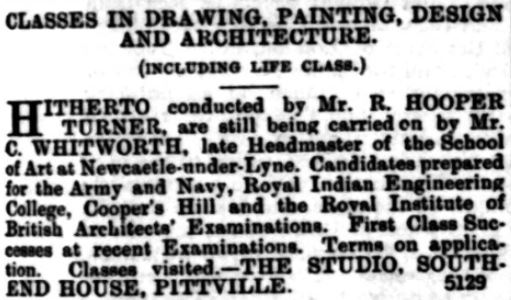
Advertisement announcing Robert Turner’s replacement as art teacher
at Southend House (Cheltenham Examiner, 25 November 1903)
The school is recorded in the electoral register of 1921 and the entry in the 1921 census indicates that the school, still under Agnes, was then accommodating those whom we would now describe as having learning difficulties. Six students are listed, all female, with ages ranging from 7 to 36. They come from many parts of England: Cheshire, London, Hertfordshire and Staffordshire.
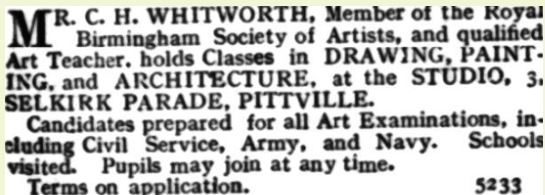
Charles Whitworth’s advertisement for art classes at 3 Selkirk Parade
(Cheltenham Examiner, 1 August 1906)


at Southend House (Cheltenham Examiner, 25 November 1903)

(Cheltenham Examiner, 1 August 1906)
Ravenhurst, Pittville Lawn
Ravenhurst, on Pittville Lawn, was the site of a nursery in the late 1930s and 1940s. The school appears variously as a nursery ‘home’, fostering up to ten babies and small children, and a nursery ‘school’, offering a class. It was run by Miss Diana Burmester, who had been born in Hertfordshire but by 1936 was living in Cheltenham. The nursery seems to have been originally established at Glenrise on Harp Hill, Miss Burmester’s home at the time, and moved to the Pittville Lawn site in October 1936, when she advertised a new morning class for ‘a few young children’. In 1937 she made a successful application as a foster mother to care for up to ten infants.
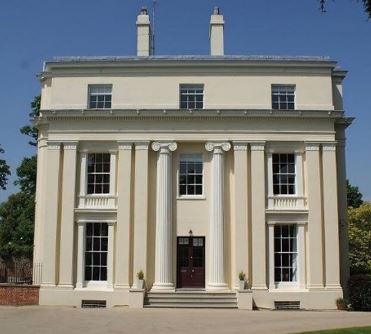
Ravenhurst on Pittville Lawn, the site of a nursery school
in the 1930s and 1940s
Between 1936 and 1945 there were several advertisements for staff – either the business was expanding or staff tended not to stay long. The school seems still to have been active in 1944, when Miss Burmester was fined for failing to observe the wartime blackout regulations (several years earlier she had been fined for leaving her vehicle so as to cause an obstruction in the Colonnade – between Boots Corner and Martins Jewellers), but in November 1945 a successful planning application was made to Cheltenham Borough Council to convert Ravenhurst into flats. The electoral register of 1946 shows at least four households there, so it appears that the school had closed by then. Miss Burmester died in Hastings in 1995, aged 87.

in the 1930s and 1940s
Godwynhurst School, Pittville Lawn

Kenilworth on Pittville Lawn, once the site of Godwynhurst School
During the 1920s the school was a day- and boarding-school for girls up to the age of nineteen; by 1928 it served as a preparatory school for boys as well. Schools in the town often had to use games pitches and playing fields at some distance and an application was recorded in the Borough Council minutes of 13 February 1939 for the use of St Mark’s hockey pitch by Overton House School. (The girls of the Grammar School also had to walk to Battledown for their games pitches while their school was at St Margaret’s Road.)
In 1941 ‘a completely new regime’ was announced, with the school now under a ‘well-known educationalist’, Mrs Hugh Maclean. The youngest pupils would be taught using the Froebel system, learning through experience and play. The advertisement somewhat archly warns off parents who only want large classes and mass-production. This school will only cater for the children of the professional classes! The advertisement of July 1943 mentions a ‘Seaside Summer House’.
Most of the newspaper cuttings available relate to the school’s artistic achievements in Royal Drawing Society exams, music exams, and the local competitive music and drama festival, but there is also an article reporting examination success in standard subjects. Former pupils of the school in Cheltenham, both boys and girls, can be found reminiscing on the Facebook group Days Gone By in Cheltenham.

Miss Humpleby’s Preparatory Establishment for Young Gentlemen, 4 Selkirk Parade (now 65 Prestbury Road)

By 1872 Miss Humpleby had moved to Selkirk Parade.
Cheltenham Looker-On, 14 September 1872
Although the school was advertised for boys, an advertisement in 1872 for the ‘Preparatory School for Boarders and Daily Pupils’ suggests its range was broadening, and in 1871 the other boarding residents were Mary Teague and Emily and Francis Chapman, aged 12, 6, and 5 respectively. Mary Teague, who came from the Forest of Dean, may well have been a pupil-teacher, helping with the younger pupils, later becoming a governess to the daughters of a farming family near Droitwich. Emily and Francis Chapman were from a well-known local family who had been near neighbours of Mary Humpleby in Sussex Villas. In the 1860s the family moved to the detached Oaklands, a large house further up Prestbury Road, with outbuildings, stabling, and an orchard. (The house still stands, set back from Prestbury Road, now obscured from view by the houses since built on Oaklands’ land.) In October 1869 their mother (by then ‘well-known in the country’) was returning from seeing their father off at the station when she was thrown out of her carriage in Winchcombe Street – seriously, though not fatally, injured. Robert Chapman was a dealer in horses for the gentry and would travel to race meetings across the country. At the wedding of Emily’s elder sister, at St Mary’s Prestbury on New Year’s Eve 1879, guests included the local MP James Agg-Gardner, the Duke and Duchess of Beaufort, and Lord and Lady Fitzhardinge. Francis Chapman later went into the Army. (For more information on the Chapmans, see ‘Mary Chapman’ at Retirement from the East Indies – in Pittville on this site.)
In 1878 Miss Humpleby moved along the terrace to No. 11 (now 51 Prestbury Road). In 1881 her occupation is still listed as Instructress, so it is likely that she was still running some sort of school. The last known entry for her at this address is found in 1885, by which time she would have been about sixty-five and presumably in retirement. In 1881 the occupants of No. 4 were Emma Lailey, living on her ‘own means’, and her daughter Elizabeth. In 1891 Miss Humpleby was living with her nephew in Camberwell, where she died in 1906.

4 Selkirk Parade, where Miss Humpleby ran her Preparatory School. To the left is No. 3,
sometime residence of Charles Whitworth, art tutor at Pittville Preparatory School
at Southend House just down the road.

Cheltenham Looker-On, 14 September 1872

sometime residence of Charles Whitworth, art tutor at Pittville Preparatory School
at Southend House just down the road.
Pate’s Grammar School for Girls
In 1990 a former pupil of ‘Cheltenham’s Other Girls’ School’, Barbara King, published a booklet* to capture the history of Pate’s Grammar School for Girls and to preserve the account of the Girls’ School as a separate entity before it merged with Cheltenham Grammar School under the Pate’s Foundation.
The foundation stone for a new building to house Pate’s Grammar School for Girls was laid at the Albert Road site on 23 July 1938, and the ceremony marked the end of several years of campaigning for a larger site to accommodate the pupils. The school had been founded in 1905 (231 years after the boys’ school), and until 1939 was housed in Livorno Lodge on the corner of North Street and St Margaret’s Road. In 1926 the Chairman of the Governors had emphasised new plans for the school – a separate playing field and a new school building. In the school’s first years the girls had to walk to the playing field at Battledown for games. The new playing field was behind Wellington Square and came into use in 1927.
In early September 1939 volunteers moved everything up the road to the new school, but it was still unfinished when the Autumn Term began – and war had just broken out. Girls from King Edward’s High School Birmingham had been evacuated to Cheltenham for safety, so a time-share system operated, with the Cheltenham girls using the building in the morning and the Birmingham girls in the afternoon. Various improvements were added over the years – glass was put in the walkways (many former pupils have memories of snow and rain blowing in), a swimming pool was built, and a domestic science block added. In 1986 the girls’ and boys’ schools merged and became Pate’s Grammar School, on the site then occupied by the boys’ school in Princess Elizabeth Way. The Albert Road building is now the site of Pittville School, a mixed comprehensive for 11- to 16-year-olds. (See also Pate’s Girls Grammar School at John Simpson’s ‘A gazetteer of Pittville house names in the 19th and early 20th centuries’ on this site.
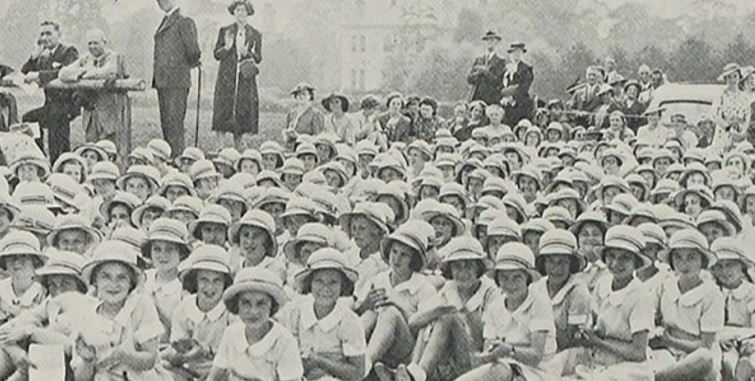
PGSG girls at the foundation stone ceremony, Albert Road, July 1938
The Cheltenham Chronicle and Gloucester Graphic

The Cheltenham Chronicle and Gloucester Graphic
Pittville School of Dancing (Lister Dance School)
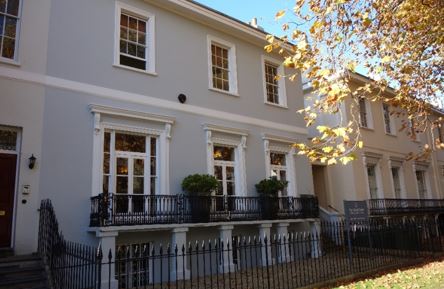
Montague Villa, now 6 Pittville Lawn, once the site of
the Pittville School of Dancing
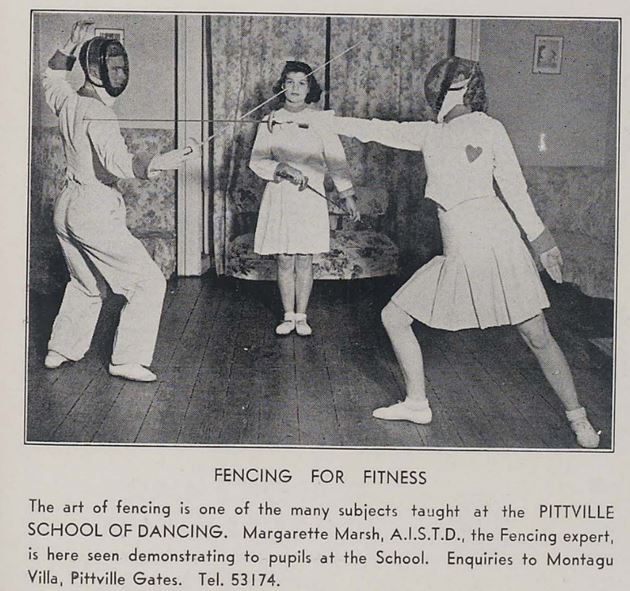
A fencing lesson at the Pittville School of Dancing
The Cheltenham Chronicle and Gloucester Graphic
Further research may well uncover more about education in Pittville, and although most of the schools no longer exist, former teachers and pupils of the more recent establishments share memories in local history projects and on forums sites such as the Days Gone By in Cheltenham Facebook group. While some schools were short-lived, others thrived for several decades, and all formed part of the tradition of private education which still remains strong in Cheltenham.
Sandy Marshall
January 2022

the Pittville School of Dancing

The Cheltenham Chronicle and Gloucester Graphic